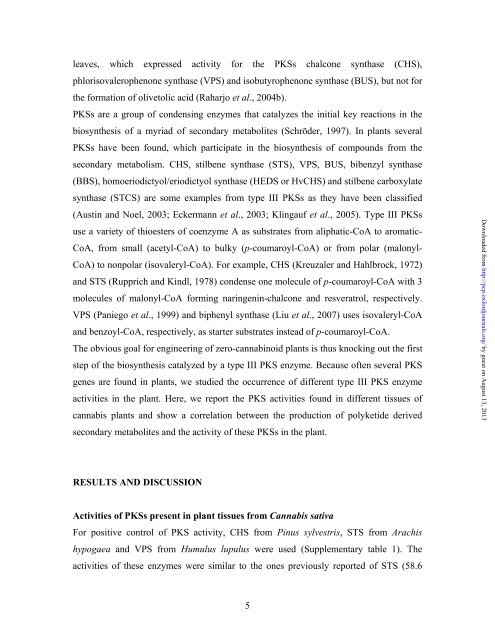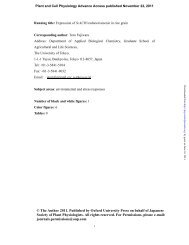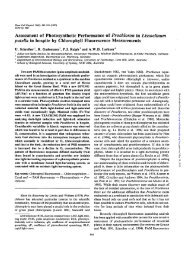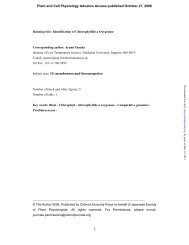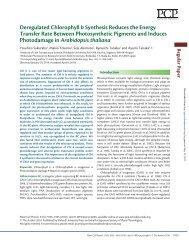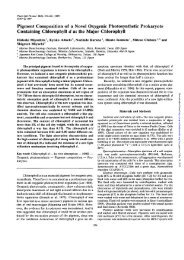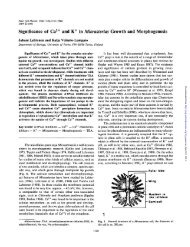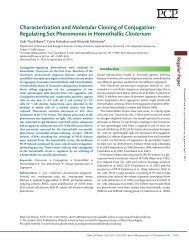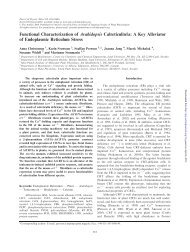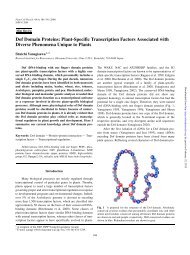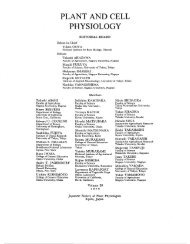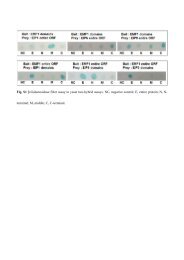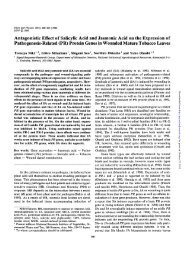1 Running title: PKSs and, cannabinoid and flavonoid accumulation ...
1 Running title: PKSs and, cannabinoid and flavonoid accumulation ...
1 Running title: PKSs and, cannabinoid and flavonoid accumulation ...
You also want an ePaper? Increase the reach of your titles
YUMPU automatically turns print PDFs into web optimized ePapers that Google loves.
leaves, which expressed activity for the <strong>PKSs</strong> chalcone synthase (CHS),<br />
phlorisovalerophenone synthase (VPS) <strong>and</strong> isobutyrophenone synthase (BUS), but not for<br />
the formation of olivetolic acid (Raharjo et al., 2004b).<br />
<strong>PKSs</strong> are a group of condensing enzymes that catalyzes the initial key reactions in the<br />
biosynthesis of a myriad of secondary metabolites (Schröder, 1997). In plants several<br />
<strong>PKSs</strong> have been found, which participate in the biosynthesis of compounds from the<br />
secondary metabolism. CHS, stilbene synthase (STS), VPS, BUS, bibenzyl synthase<br />
(BBS), homoeriodictyol/eriodictyol synthase (HEDS or HvCHS) <strong>and</strong> stilbene carboxylate<br />
synthase (STCS) are some examples from type III <strong>PKSs</strong> as they have been classified<br />
(Austin <strong>and</strong> Noel, 2003; Eckermann et al., 2003; Klingauf et al., 2005). Type III <strong>PKSs</strong><br />
use a variety of thioesters of coenzyme A as substrates from aliphatic-CoA to aromatic-<br />
CoA, from small (acetyl-CoA) to bulky (p-coumaroyl-CoA) or from polar (malonyl-<br />
CoA) to nonpolar (isovaleryl-CoA). For example, CHS (Kreuzaler <strong>and</strong> Hahlbrock, 1972)<br />
<strong>and</strong> STS (Rupprich <strong>and</strong> Kindl, 1978) condense one molecule of p-coumaroyl-CoA with 3<br />
molecules of malonyl-CoA forming naringenin-chalcone <strong>and</strong> resveratrol, respectively.<br />
VPS (Paniego et al., 1999) <strong>and</strong> biphenyl synthase (Liu et al., 2007) uses isovaleryl-CoA<br />
<strong>and</strong> benzoyl-CoA, respectively, as starter substrates instead of p-coumaroyl-CoA.<br />
The obvious goal for engineering of zero-<strong>cannabinoid</strong> plants is thus knocking out the first<br />
step of the biosynthesis catalyzed by a type III PKS enzyme. Because often several PKS<br />
genes are found in plants, we studied the occurrence of different type III PKS enzyme<br />
activities in the plant. Here, we report the PKS activities found in different tissues of<br />
cannabis plants <strong>and</strong> show a correlation between the production of polyketide derived<br />
secondary metabolites <strong>and</strong> the activity of these <strong>PKSs</strong> in the plant.<br />
RESULTS AND DISCUSSION<br />
Activities of <strong>PKSs</strong> present in plant tissues from Cannabis sativa<br />
For positive control of PKS activity, CHS from Pinus sylvestris, STS from Arachis<br />
hypogaea <strong>and</strong> VPS from Humulus lupulus were used (Supplementary table 1). The<br />
activities of these enzymes were similar to the ones previously reported of STS (58.6<br />
5<br />
Downloaded from<br />
http://pcp.oxfordjournals.org/ by guest on August 13, 2013


